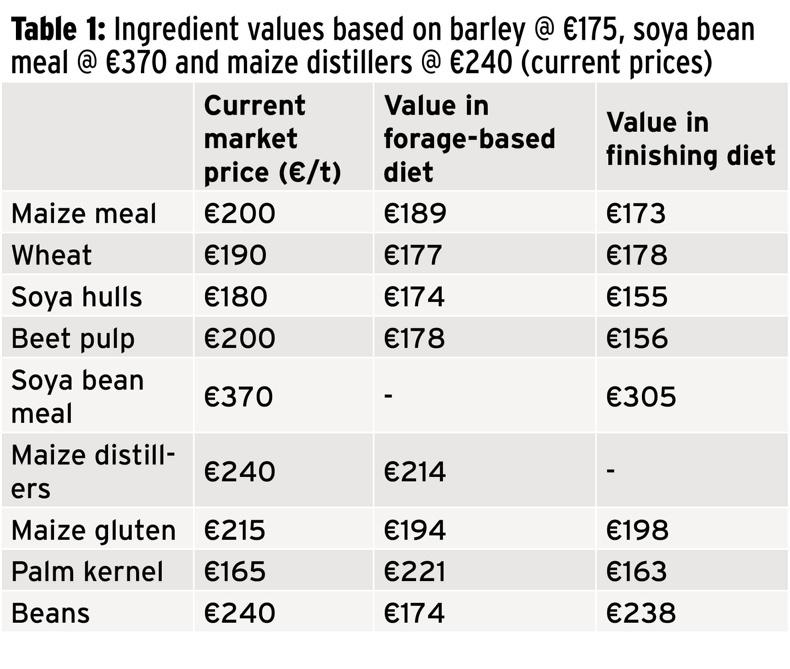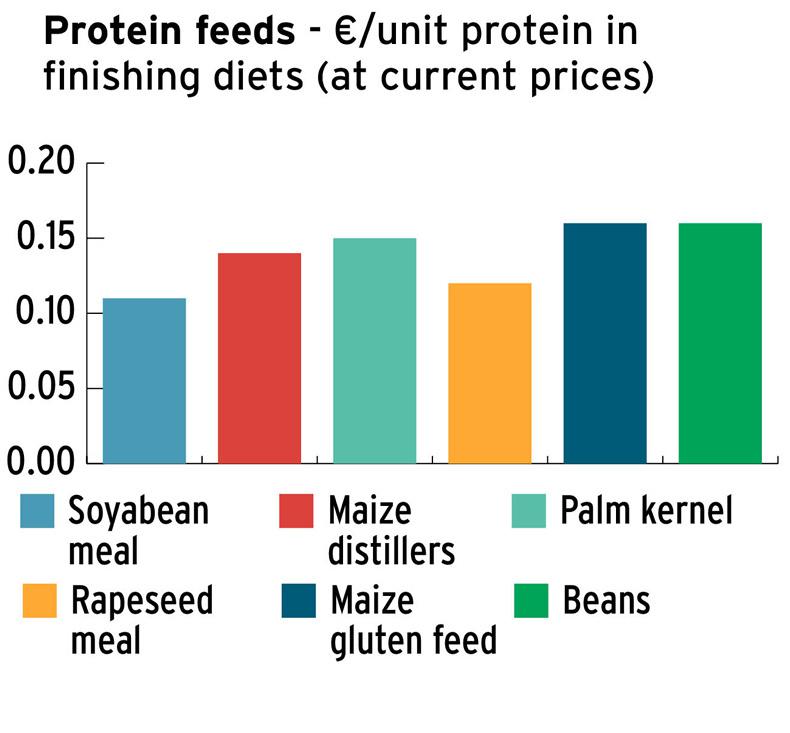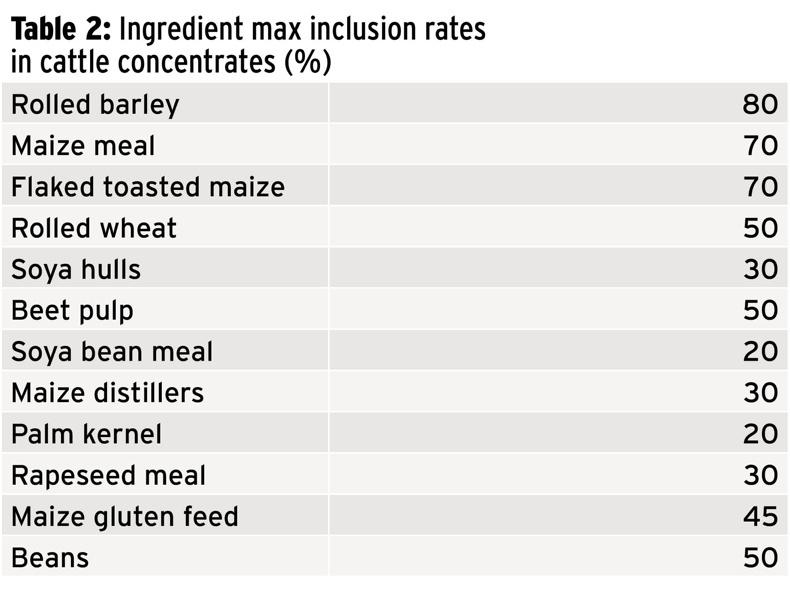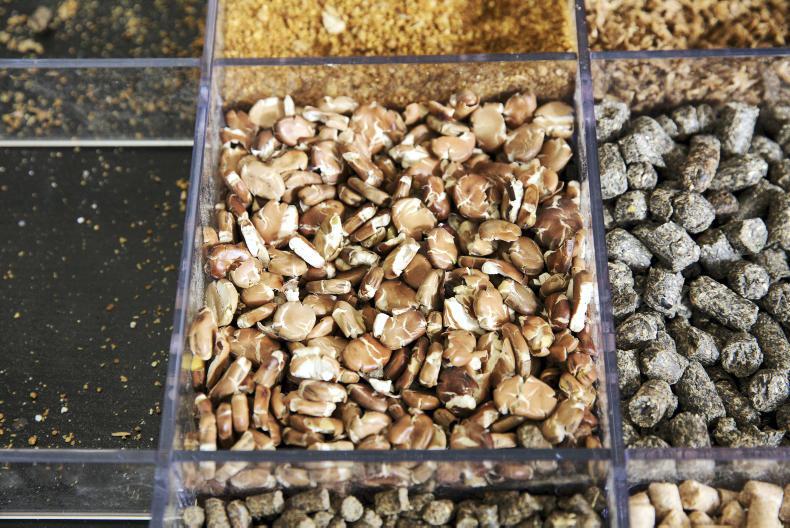With winter feeding just around the corner, it’s important to have an understanding of what should be in our meal bins and why.
For those producers buying straight ingredients, it’s also vital to know where the value lies.
Beef finishing
concentrate
For feeding at high rates (>5kg) for rapid weight gain. Animal will have framed-up at this stage. Focus on laying down lean muscle and fat as quickly as possible.
Ingredients to look out for: cereals.Target crude protein (CP): 11-13%.Target UFL/kg (ME/kg): 0.94 (12).Price: €225-260.Beef growing
concentrate
For feeding weanlings. Offered as supplement to grass silage – rate depends on forage quality. Animal has high protein requirement as they’re still laying down significant amounts of frame.
Ingredients to look out for: cereals, soya bean meal, gluten, distillers, beans, molasses. Target CP: 15-17%.Target UFL/kg (ME/kg): 0.92 (11.7).Price: €230-270.Calf-starter
concentrate
Need high-quality ingredients. Should be coarse to stimulate digestion and high in cereals to stimulate rumen development. Molasses will help with intake.
Ingredients to look for: maize, barley, soya bean meal, molassesTarget CP: 17-20%.Target UFL/kg (ME/kg): 0.95 (12.1).Price: €265-300.Multi-purpose mix
For those with a single meal bin, aim for a simple mixture that can be fed, along with silage to finishing stock, weanlings and thin cows/first-calvers. These rations will be unsuitable for finishing bulls at high inclusion rates, but fine for a bullock/heifer finishing (4-6kg) with silage. For example: 40% rolled barley, 30% maize meal, 30% maize gluten. Performance on such a ration may not be at optimum level, but there are obvious advantages in terms of price and ease of storage.
Ingredients to look for: cereals, gluten, hulls, distillers.Target CP: 14-15%.Price: €205-235.Protein balancer
For feeding with home-produced energy ingredients (cereals/beet).
For finishing cattle, include 30% of this mix with 70% energy – 13% CP overall. For growing cattle, feed 50% balancer and 50% energy – 17% CP. Example: 25% beans, 45% soya hulls, 30% rapeseed meal. Ensure to include a relevant mineral mix in DIY concentrate rations.
Target CP: 20-22%.Price: €220-240.Putting a value on straight ingredients
The saying suggests you should never judge a book by its cover – the same goes for feed ingredients. When quoted a big price for a tonne of an ingredient, ask what’s in that tonne. While energy ingredients are straightforward, valuing protein ingredients can be mind-bending.
Current popular feed ingredients and their prices are listed below (Table 1). To the right, these ingredients are presented relative to each other, based on the amounts of energy and protein we get at these prices.

There are two graphs for protein as the value of the feed to the animal depends on its complete diet.


Current value – protein
With soya bean meal likely to trade close to €370 for the coming months, few other ingredients touch it in terms of value. While it’s the most expensive ingredient on the page, the concentration and quality of its protein means that when buying animal performance, it’s relatively cost-efficient at present. While palm kernel seems cheap, the reality is that it is not very palatable and will affect performance at high inclusion rates (see Table 2). However, it is a good source of fibre and is included in many types of ration.

Current value – energy
The value at present lies with barley. However, with question marks over grain quality this year, it is always worth including the likes of maize or wheat as an insurance policy. Maize is an excellent source of starch, and less likely to cause digestive upsets compared with other cereals. It often outperforms its quoted feeding values too.

Relative values
Table 1 outlines the current relative value of feed ingredients. Put simply, this is what you would need to be paying for these ingredients to justify replacing barley, soya bean meal or distillers grains with these ingredients as sources of energy and protein. Distillers represent a great multipurpose option in finishing rations
Remember, while ingredients like hulls, pulps, palm kernel and gluten mightn’t always seem attractive economically, they have roles as forces of digestible fibre in the vast majority of ration types. When formulating diets, supply and demand of various ingredients must be taken into account.
Beans seem to be the popular feed this year, creeping in to lots of different types of rations. At current prices, they represent good value as a protein source in finishing diets.
Read more
Focus: Winter feed
What can my silage do for me this winter?
How far will my silage go this winter?
With winter feeding just around the corner, it’s important to have an understanding of what should be in our meal bins and why.
For those producers buying straight ingredients, it’s also vital to know where the value lies.
Beef finishing
concentrate
For feeding at high rates (>5kg) for rapid weight gain. Animal will have framed-up at this stage. Focus on laying down lean muscle and fat as quickly as possible.
Ingredients to look out for: cereals.Target crude protein (CP): 11-13%.Target UFL/kg (ME/kg): 0.94 (12).Price: €225-260.Beef growing
concentrate
For feeding weanlings. Offered as supplement to grass silage – rate depends on forage quality. Animal has high protein requirement as they’re still laying down significant amounts of frame.
Ingredients to look out for: cereals, soya bean meal, gluten, distillers, beans, molasses. Target CP: 15-17%.Target UFL/kg (ME/kg): 0.92 (11.7).Price: €230-270.Calf-starter
concentrate
Need high-quality ingredients. Should be coarse to stimulate digestion and high in cereals to stimulate rumen development. Molasses will help with intake.
Ingredients to look for: maize, barley, soya bean meal, molassesTarget CP: 17-20%.Target UFL/kg (ME/kg): 0.95 (12.1).Price: €265-300.Multi-purpose mix
For those with a single meal bin, aim for a simple mixture that can be fed, along with silage to finishing stock, weanlings and thin cows/first-calvers. These rations will be unsuitable for finishing bulls at high inclusion rates, but fine for a bullock/heifer finishing (4-6kg) with silage. For example: 40% rolled barley, 30% maize meal, 30% maize gluten. Performance on such a ration may not be at optimum level, but there are obvious advantages in terms of price and ease of storage.
Ingredients to look for: cereals, gluten, hulls, distillers.Target CP: 14-15%.Price: €205-235.Protein balancer
For feeding with home-produced energy ingredients (cereals/beet).
For finishing cattle, include 30% of this mix with 70% energy – 13% CP overall. For growing cattle, feed 50% balancer and 50% energy – 17% CP. Example: 25% beans, 45% soya hulls, 30% rapeseed meal. Ensure to include a relevant mineral mix in DIY concentrate rations.
Target CP: 20-22%.Price: €220-240.Putting a value on straight ingredients
The saying suggests you should never judge a book by its cover – the same goes for feed ingredients. When quoted a big price for a tonne of an ingredient, ask what’s in that tonne. While energy ingredients are straightforward, valuing protein ingredients can be mind-bending.
Current popular feed ingredients and their prices are listed below (Table 1). To the right, these ingredients are presented relative to each other, based on the amounts of energy and protein we get at these prices.

There are two graphs for protein as the value of the feed to the animal depends on its complete diet.


Current value – protein
With soya bean meal likely to trade close to €370 for the coming months, few other ingredients touch it in terms of value. While it’s the most expensive ingredient on the page, the concentration and quality of its protein means that when buying animal performance, it’s relatively cost-efficient at present. While palm kernel seems cheap, the reality is that it is not very palatable and will affect performance at high inclusion rates (see Table 2). However, it is a good source of fibre and is included in many types of ration.

Current value – energy
The value at present lies with barley. However, with question marks over grain quality this year, it is always worth including the likes of maize or wheat as an insurance policy. Maize is an excellent source of starch, and less likely to cause digestive upsets compared with other cereals. It often outperforms its quoted feeding values too.

Relative values
Table 1 outlines the current relative value of feed ingredients. Put simply, this is what you would need to be paying for these ingredients to justify replacing barley, soya bean meal or distillers grains with these ingredients as sources of energy and protein. Distillers represent a great multipurpose option in finishing rations
Remember, while ingredients like hulls, pulps, palm kernel and gluten mightn’t always seem attractive economically, they have roles as forces of digestible fibre in the vast majority of ration types. When formulating diets, supply and demand of various ingredients must be taken into account.
Beans seem to be the popular feed this year, creeping in to lots of different types of rations. At current prices, they represent good value as a protein source in finishing diets.
Read more
Focus: Winter feed
What can my silage do for me this winter?
How far will my silage go this winter?











 This is a subscriber-only article
This is a subscriber-only article




















SHARING OPTIONS: